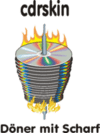libburnia
 | |
| Developer(s) | Mario Đanić, Vreixo Formoso Lopes, Thomas Schmitt |
|---|---|
| Stable release |
1.4.4 [1]
/ July 1, 2016 |
| Written in | C, Unix Shell |
| Operating system | FreeBSD, Linux, NetBSD, Solaris |
| Type | Optical disc operations |
| License | GPL |
| Website |
libburnia-project |
libburnia is a free software library and collection of command-line interface (CLI) for burning CDs, DVDs and Blu-ray media.
Libburnia overview
Libburnia is the name of a project to develop various pieces of disk recording software.
- libburn is the underlying programming library. It is used by xorriso, cdrskin and 3rd party disk recording applications can also use this library directly.
- libisofs is the library to create or modify ISO 9660 disk images.
- libisoburn is an add-on to libburn and libisofs which coordinates both and also allows to grow ISO 9660 filesystem images on multi-session and overwriteable media.
- xorriso is a CLI application that creates, loads, manipulates and writes ISO 9660 filesystem images with Rock Ridge extensions.
- cdrskin is the end-user application of libburnia. It is CLI-only and its syntax is mostly identical to cdrecord to act as a drop-in replacement for existing front-ends.[2]
Xorriso
Xorriso stands for X/Open, Rock Ridge ISO and is the main command-line tool included with libburnia. It allows both generation and (to some extent) update of image files as well as burning images to the disk.
It provides a command-line interface for single operations as well as GNU Readline and Dialog-based interfaces.
Uses
- The underlying libburn library is used directly as sole recording back-end for Xfce’s graphical Xfburn application[3] which is included in the default installation of Xubuntu since version 10.10.[4]
- GNOME's default disk recording application, Brasero, can use libburn directly without relying on cdrecord compatibility of cdrskin.[5]
- FlBurn is a FLTK application that uses libburn directly.[6]
- cdrskin is similar to cdrecord and wodim, and can be used in place of the aforementioned tool in GUI front-ends such as K3b.[7]
History
The first public release of libburnia, libburn-0.2.2, was in September 2006.
The current stable version is 1.4.4, which was released on July 1st 2016.[1]
Features
- Blanking/formatting of CD-RW DVD-RW, DVD+RW, DVD-RAM, BD
- Burning of data or audio tracks to CD, either in versatile Track-at-Once mode (TAO) or in Session-at-Once mode for seamless tracks.
- Multi-session on CD (follow-up sessions in TAO only) or on DVD-R[W] (in Incremental mode) or on DVD+R.
- Single session on DVD-RW or DVD-R (Disk-at-once) or on over-writable DVD+RW, DVD-RW, DVD-RAM, BD-RE.
- Bus scan, burn-free, speed options, retrieving media info, padding, fifo.
- Works with SATA DVD drives.
- Write access to disk images.
- Use UNIX device path (/dev/hdX) on Linux
- You do not need to be superuser for its daily usage.[8]
See also
References
- 1 2 Release Page
- ↑ cdrskin README file
- ↑ Xfburn website
- ↑ Xubuntu 10.10 release information
- ↑ Brasero website
- ↑ FlBurn website
- ↑ https://help.ubuntu.com/community/K3BHowto
- ↑ http://manpages.ubuntu.com/manpages/natty/man1/cdrskin.1.html
External links
This article is issued from Wikipedia - version of the 8/17/2016. The text is available under the Creative Commons Attribution/Share Alike but additional terms may apply for the media files.